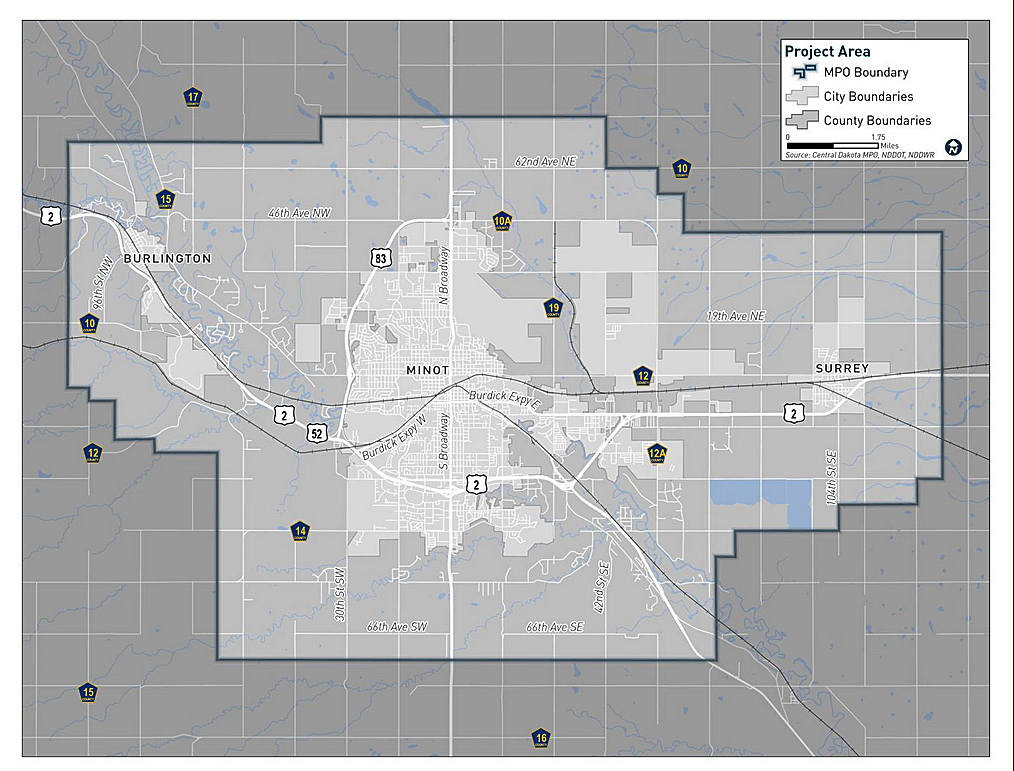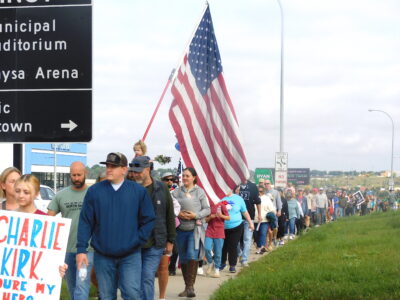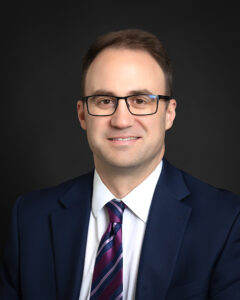No shortage of proposed transportation projects
Public input essential to plan development

Submitted Graphic A map shows the area included in the Central Dakota Metropolitan Planning Organization. Graphic courtesy of CDMPO.
Proposed projects exceed projected federal funds when it comes to making transportation improvements in the Minot area.
The Central Dakota Metropolitan Planning Organization, along with consulting firms Bolton & Menk and SRF, outlined the progress with development of a transportation plan while also hearing from the public at a virtual meeting Tuesday.
Projections show $242 million potentially available in federal funds over the next 25 years. In the short-term, from 2026-2030, $42 million of those project funds have been assigned, said project manager Angie Stenson with Bolton & Menk. That leaves $200 million available for longer range planning.
The transportation plan under development shows $301 million in possible projects to reconstruct roadways or improve mobility on roadways in the 2031-2050 timeframe. Meanwhile only $156 million is potentially available from the federal government for those categories.
“This is expected with any planning process where we dig into what might be needed. Really, this thorough, long-term issues analysis that was completed, as well as community and agency project identification process, is very likely to uncover more needs than available funding,” Stenson said.
Going forward, public input is sought regarding whether reconstruction or mobility projects have greater priority and which projects in those categories rise to the top.
Reconstruction projects involve substantial changes to a roadway to modernize the layout, improve safety and usability and can include adding turn lanes, reducing lanes and access modifications.
“Overall, 16 regional projects were identified as needed for the time period between 2031 and 2050,” Stenson said of reconstruction projects. “These projects are estimated to require approximately $149 million of federal transportation investment.”
Among those roadways are Broadway, Fourth Avenue Northwest and 13th Street Southeast.
In addition, 13 mobility projects that address congestion or create new roadway connections to improve traffic operations were identified, at a cost of $152 million. Among the roadways are 30th Avenue Northwest, a portion of 30th Street Southwest on the south side of the U.S. 2/52 Bypass and 62nd Street and 66th Avenue along Minot’s southwest side.
Additionally, planning so far has identified nine multi-modal projects, involving pedestrians and bicycles, totaling $19 million.
About $25 million is projected to be available in federal safety funding from 2031-2050 for projects specifically designed for safety, although several reconstruction and mobility projects also include safety features, Stenson said.
The Central Dakota MPO takes in Minot, Surrey, Burlington and rural areas in between. The MPO has a technical advisory committee and a policy board that includes representatives of the communities and Ward County.
The board is tasked with developing a transportation plan, or strategic framework to shape the future of transportation in the area, said MPO Executive Director John Van Dyke.
“It’s going to be instrumental in guiding future transportation projects and ensuring that, effectively, the entire region has a shared vision for the area’s transportation system,” he said.
Van Dyke explained metropolitan planning organizations were instituted with the creation of the interstate highway system to bring some local control into the decision making by federal and state transportation departments. The Minot area set up an MPO after a federal determination that a population base of 50,000 or more existed.
Tuesday’s public meeting sought to answer questions from the public and get input into the plan development so far. With the input, the preliminary plan will be refined and presented to the communities for additional input in a couple of months.
Stenson said safety was the primary goal identified from previous public input into plan development. Other goals of a transportation plan are promoting economic development and investment, maintaining infrastructure condition and operations, and providing mobility and accessibility.
The intent is to provide safety, options and connectivity for all users, including traditional motorists, pedestrians, bicyclists, transit riders and freight operators, Stenson said.
To view Tuesday’s presentation or maps showing project areas, visit the city website at minotnd.org, search for and select Metropolitan Planning Organization and click on Move2050.




